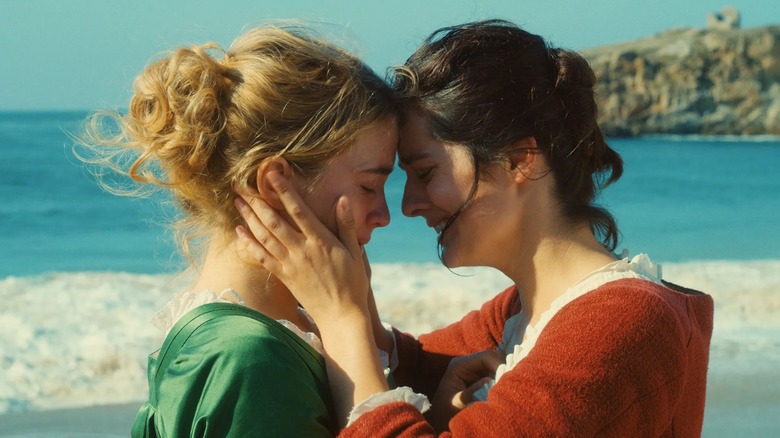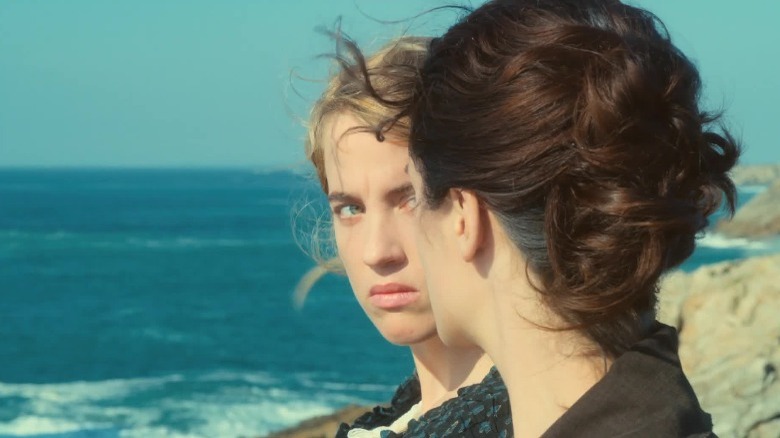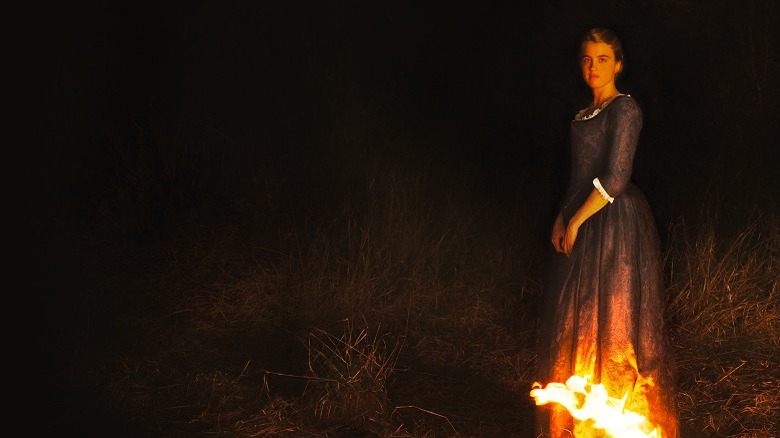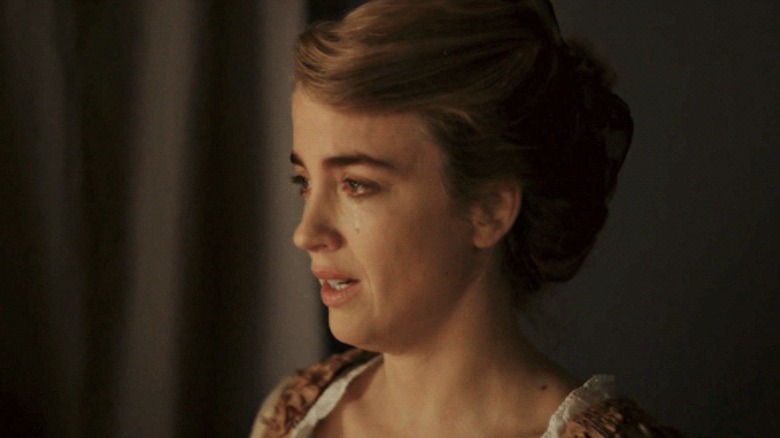Portrait Of A Lady On Fire Ending Explained: Memory And Longing Arrive Like A Summer Storm
The myth of Orpheus and Eurydice poses an essential question: Why does Orpheus look back? Despite being aware that a single backward glance can drag his lover back to the underworld, Orpheus, overwhelmed by his intense emotions, gazes at Eurydice for a final time. This Greek myth welcomes a wide range of interpretations, some of which are discussed and debated by Marianne (Noémie Merlant) and Héloïse (Adèle Haenel) in Céline Sciamma's stunningly transformative "Portrait of a Lady on Fire." While Marianne thinks that Orpheus makes "the poet's choice" to capture Eurydice's memory, Héloïse argues that perhaps Eurydice was the one who asked him to look back in tender longing. However, there are no right or wrong answers when it comes to dissecting eon-old myths. Both Marianne and Héloïse play out their own versions of the mythical figures when it comes to the love they share for one another.
Sciamma does not restrict the motif of the female gaze to the myth incorporated into the film's central relationship. She builds the world of "Portrait of a Lady on Fire" on Marianne's vivid, sensitive observation of Héloïse, who views the latter through the dual lens of an artist and a lover. However, in stark contrast to the male gaze, which is traditionally overpowering and often dehumanizing, Marianne's gaze invites autonomy and reciprocity. Both women in the romantic dynamic are equals, despite worldly chasms in socioeconomic status; despite sharing unbearable, heartbreaking tenderness that is meant to be short-lived, there is unrestrained freedom in this bond. Neither of them look back in anger. Instead, memory and desire become means of honoring the passion they felt for one another on an idyllic island on the northern coast of France.
Gazing, longing, and daring to dream
When Marianne arrives in Brittany, she has a solitary task expected of her: She must strike a friendship with Héloïse in order to memorize her features for a portrait. This would obviously involve some level of deception, as Héloïse is unaware of Marianne's mission, and has previously refused to sit for commissioned portraits. Although Héloïse goes on walks with Marianne on the beach, both her body language and gaze are guarded, as she is unsure about the newcomer. Marianne, devoted to her craft, regards Héloïse with the intensity of an artist, only for her scrutinizing examinations to evolve into tender gazes of longing. When Héloïse gazes back with the same passion, a spark of mutual love and longing is ignited.
"Portrait" paints a heartbreaking, bittersweet picture of two people in love, who are socially forbidden from ending up together, especially during the time-frame the story is set in. However, while Marianne and Héloïse's romance is doomed from the get-go, their love for one another still matters, as it helps them grieve, evolve, and rediscover themselves long after the relationship ends. A relationship cut short, or one that never culminated, remains a love story — one that lives on through memory, desire, longing, and nostalgia for what could've been.
Marianne's gaze contextualizes the love story between the two women, including the ending, in which we see an unguarded Héloïse expressing her deep love for Marianne without uttering a single word. Although Marianne only spends two weeks with Héloïse in Brittany, the romantic/erotic tension unravels unhurriedly, and the two communicate almost entirely by looking at one another. When not debating mythic figures, they turn to art to proclaim their love.
Art as a vehicle for memory and longing
At the beginning of the film, one of Marianne's students reveal a painting of Héloïse, where her dress is literally ablaze. This is not only an artist's perception of her lover but a memory of the night of a bonfire. This is a pivotal moment for Marianne, as the vivid image of Héloïse on fire — which is also a passionate declaration of her love — has been branded in the artist's memory, allowing her to memorize her features. The painting, which triggers the memory of that magical moment, also immortalizes Marianne's passion for Héloïse, which is still searing, painful, and unforgettable.
Another instance of a portrait symbolizing the act of remembering lost love is the one Marianne stumbles upon in a museum. It is a portrait of Héloïse, radiant alongside her daughter, with a book in her hands opened slightly to page 28. This seemingly inconspicuous page number is neither an accident nor a creative decision by the painter. Instead, Héloïse has made the conscious choice to pose with this particular book turned to the same page on which Marianne had sketched a nude self-portrait after the two slept together. The portrait, although etched years after the lovers' separation, with Héloïse married to a Milanese nobleman, still carries deliberate evidence of her love, longing, and memory of Marianne.
Circling back to the Orpheus myth, Marianne acts out her interpretation through the painting of the two lovers. She, the poet/artist, is Orpheus, who chose to let go of her Eurydice and hold onto her memory instead. However, the choice is a democratic one, as Héloïse, as Eurydice, also made the decision to be let go.
Music, a reminder of what could have been
In the final scene, Marianne finds herself seated opposite Héloïse during an orchestra performance, with the latter unaware of her presence. As the Presto segment of "Summer" from Antonio Vivaldi's "Four Seasons" swells, Marianne's (and our) gaze closes in on Héloïse, who begins to weep passionately. This is not just an emotional reaction to powerful art, but an act of grieving when a dear memory comes back to haunt her. Turns out, four years back, Marianne had played this particular section for Héloïse on her harpsichord to introduce her to the beauty of orchestral music. For Héloïse, Vivaldi's "Summer" will always be associated with Marianne, her memory, and what could have been.
Longing and nostalgia can hit us like an unexpected summer storm, which is precisely what the Presto segment is about. The moment is bittersweet for both the observer and the observed, as it is a stinging reminder of their unrealized love. However, the film's ending is not completely devoid of hope, as a quintessential "happy ending" is not the sole goal or flavor of love. Love can be fleeting yet transformative and hold immense value by defying the passage of time. The devastating, beautiful nature of the ending is a reminder that Marianne and Héloïse still mean something to one another; their memories of the other are still mired in yearning. While there's acceptance that things can never be the way they truly want, there's a gentle reminder that the love was real.
The final shot is that of unabashed passion and vulnerability. It is also a snapshot of how we remember those we have loved and lost, and how art prevents our most visceral emotions from turning into ash.



